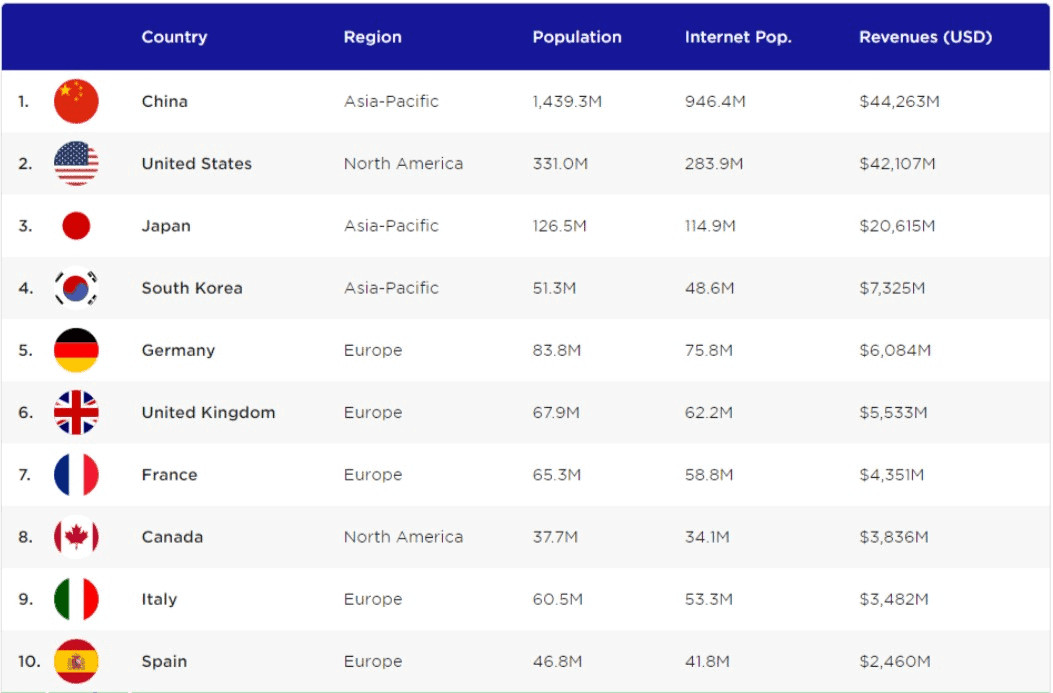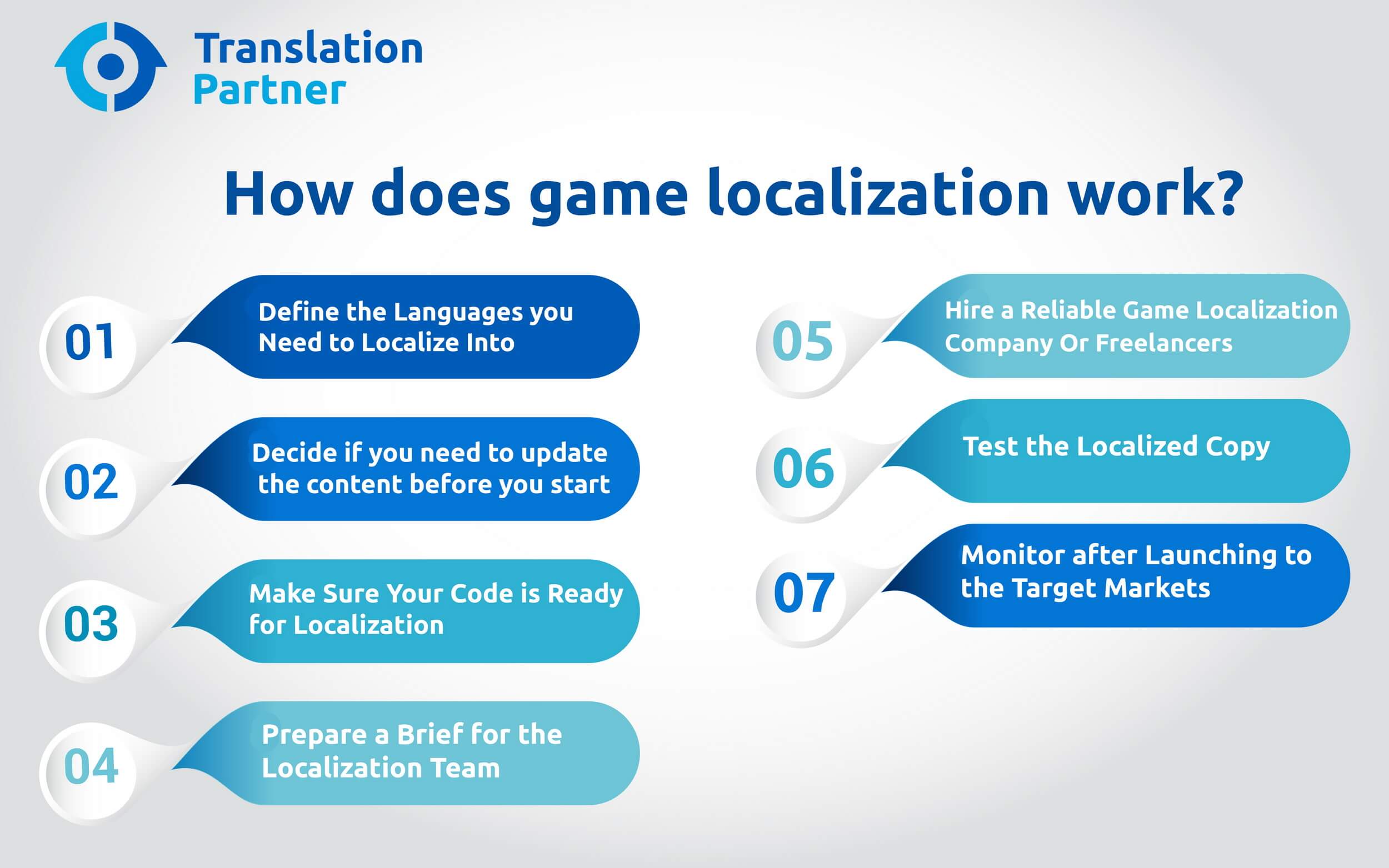Imagine you’ve created a masterpiece of a game and you want to share it with the world. How do you make sure that players from around the globe can enjoy it as much as those in your country? This is where game localization kicks in.
The video game localization process is more than just translating text or even the game audio. It’s a multi-faceted approach that requires attention to detail and cultural sensitivity.
It is a smart move to localize your game into different languages. This will help you increase the number of your downloads, and you will gain more market share.
Language is key in gaming. English is the lingua franca of the internet, however, there are other major languages you shouldn’t ignore.
More than one-third of localized games are in 4 languages, dubbed as FIGS. These languages are French, Italian, German, and Spanish. Moreover, CJK, namely Chinese, Japanese, and Korean languages, opens up vast markets of enthusiastic gamers.
Let’s not forget that languages like Russian and Portuguese mark thriving gaming communities and offer significant potential for success.
Language localization goes beyond mere translation. It creates a truly immersive experience for players worldwide.
In this article, I will walk you step-by-step to answer the question of “How to localize a game?” These steps are based on my 10 years of experience working on different localization projects and cooperating with teams from different languages and countries.
What Is Localization?
Language localization involves adapting content to a specific locale or market. It’s about making the content culturally appropriate and relevant for a specific target audience.
When you’re localizing content, you’re not just translating it. Instead, you’re adapting it to the culture, customs, and legal requirements of a specific region.
The localization process requires a full grasp of the linguistic characteristics of the target audience. These characteristics include regional dialects, idiomatic expressions, and language variations.
For example, English is widely spoken across many countries, however, it can differ significantly between regions. In countries like the United States and the United Kingdom, words, phrases, and even spellings can be different.
Skilled translators need to be familiar with the target audience’s culture. This will help them avoid using any words, phrases, or symbols that might be unintentionally offensive in that culture.
In the context of video games, localization plays a vital role in making games accessible and enjoyable for players worldwide.
The video game localization process involves translating in-game texts, including dialogue, subtitles, menus, and others, while catering to players from diverse backgrounds. It may include in-game audio localization as well.
Accordingly, game localization may undergo graphic modifications and even alterations in some storyline elements. This way, the game is particularly tailored to the target audience to suit them culturally.
How does game localization work?
These are the main 7 steps to follow to succeed in your game localization project. This is not an inclusive list, and every step may have details to be considered. You can use these 7 steps as guidelines to understand how to localize a game.
Let’s get started!
Step 1: Define the Languages you need to Localize Into
You don’t need to localize your game into all the languages under the sun. Choose the languages and markets that can make your company profitable and contribute to your long-term success.
For example, the table below shows the top 10 countries by game revenue. The revenues are based on consumer spending in each country and don’t include hardware sales, tax, business-to-business services, and online gambling and betting revenues.

Also, you may consider the countries that have an evolving number of smartphone users. They are markets you may think of entering as smartphone users spend more time holding their phones.
Also, check the analytics of your game downloads and see which countries have the most downloads. Then, localize your game to the languages of these countries, as people prefer to read the information in their native language, hence playing games in their native tongue.
Step 2: Decide if you need to update the content before you start
The game content may include elements such as images, voice messages, players’ instructions, strings, characters’ dialogue, or game descriptions.
Some of these elements will need to be adapted for the target markets. You may need to replace the images you are using if they don’t fit the markets you are localizing for.
Maybe the cartoon drawing has negative cultural effects on your target markets.
Even the characters’ names may need an update to ensure the players feel they are close to their culture. For example, a game character named “Mostafa” is more appropriate for Saudi Arabia than a name like “John”.
Make sure to cross-check the content before you start localizing your game.
Step 3: Make Sure Your Code is Ready for Localization
You will need to integrate the game content with a Translation Management System to localize the game fast and accurately. If your game code is not compatible, then the process can be harder and can cause issues in the future.
From the start, make sure your code structure follows the localization standards of the platform your game will be played on.
For example, if your game will be played on Android smartphones, make sure you follow the Android localization standards from a coding perspective.
Building a solid localization-compatible code will ensure your content is fully integrated with your translation management system and you don’t miss a string or more during the localization procedures
Still, wondering if it is worth it to localize our game? watch this quick video.
Step 4: Prepare a Brief for the Localization Team
You need to have clear instructions ready for the localization team, the ones who will translate your game into other languages.
Preparing a brief can help cut down the back and forth between you and your localization team. Also, it will help keep consistency with your brand and across all the languages you localize into.
The brief can include things such as the length of the strings, the tone of the language, how to handle characters’ names, the date formats, and any other language-related instructions.
Also, it is recommended to include a description of the game itself inside the brief. Like how the game works, the story behind it, or what makes the players win.
Request A FREE Translation Cost Estimate!
Click the below button and request a free price quote for translation services—no commitment on your side.
Step 5: Hire a Reliable Game Localization Company Or Freelancers
Whether you work with a company or a group of freelancers, every localizer you work with should be:
- Native speakers of the language they will localize into.
- Aware that this is a game localization, not translation.
- Familiar with your translation management system.
- deadline-committed to help you launch the game on time.
Working with a game localization company can help you minimize the cost of project management. The localization company will have tested and proven teams in different languages and work with localizers they trust.
This will save you the time wasted on hiring, testing and communicating with different localizers from many languages at the same time.
But working with freelancers has its advantages as well, you will have direct contact with the actual people localizing the game. So, it will mean faster and better communication.
You have to think about this decision and make a decision based on your available budget and resources.
Step 6: Test the Localized Copy
Different stakeholders are involved in the game localization process, such as developers, localizers, graphic designers, and others. It is positive to test the localized copy of the game before launching to the target markets to spot any errors that slipped through.
The testing team will check that everything works as it should from a functional, linguistic, and cultural perspective.
The functional testing will check if buttons are working correctly, links are directed to the correct parts of the game, and other functional stuff.
The linguistic testing will review the language used for spelling, grammar, punctuation, and translation issues.
The cultural testing will review the images, graphics, and all other visual elements to ensure they don’t hurt the players in the target markets.
Step 7: Monitor after Launching to the Target Markets
Games localization is tricky after all. You still need to collect feedback from real players. They can discover things that were not obvious during the game localization process.
You do this by following the conversations of the gamers around your game and seeing if they complain about anything. Cultural complaints are way more important than any other ones.
They can hurt your game reputation.

How long does it take to localize a game?
A game localization can take from 3 to 6 months. This refers to the complete process from preparing the content to testing. Also, the number of languages will affect the time it takes to localize the game.
It is better to have a plan with milestones before you start to localize the game.
For example, how many weeks should it take to localize the content only? When should the game be ready for testing? When should every language be ready for the target market?
Make sure to consult with the teams involved in the process to have an accurate estimate of the time it will take to localize the time.
How can you make it easier to localize your game?
Localizing your video game means you can reach new audiences and enhance player experience across different regions.
By now, you see the answer to the “how to localize a game” is not straightforward and may seem complex. However, you can make it easier by:
- Pre-planning the process
Before you start the localization process, you need to plan. First, conduct market research to identify target regions with high demand for your game genre. Then, decide the languages you want to localize your game into.
The next step is to identify milestones and your budget. Budgeting will help you prioritize languages and allocate resources effectively. You should consider the expenses of factors like translation services and cultural consultants.
You’ll also need to establish clear milestones to track progress throughout your localization journey. Break down the process into manageable stages, such as translation, culture adaptation, and testing strategy. This will keep the localization process on track to ensure timely delivery.
- Use native speakers
Native speakers know their target language better than anyone else. They have a natural understanding of their language’s nuances, idioms, and cultural references.
Their insights are extremely useful to prove that your localized game resonates with the target audience.
That’s why it’s best to collaborate with native speakers while hiring professional translators specialized in gaming terminology. This will elevate the quality of your localized game.
- Prepare clear instructions
Clear communication is key to a seamless game localization process. You need to provide your localization team with detailed instructions. To make sure the localized game aligns with your vision, outline your expectations clearly in terms of tone, style, and cultural sensitivity.
Create style guides and glossaries to maintain consistency and authenticity across all versions of your localized game.
If you’re working with a game localization company, like TranslationPartner, you can expect their localization team will do this step. You may choose to provide them with a glossary or points to consider when creating their glossary.
Consider including references to key game elements, character names, and dialogues. This will guide translators to maintain coherence throughout the localization process.
Don’t forget to regularly communicate with your localization team to address any concerns or questions to achieve optimal results.
- Use localization technology
In our digital age, localization technology offers assistance to translators. Using game localization tools not only helps you manage multilingual assets but also ensures quality control.
Consider investing in translation management systems and computer-assisted translation (CAT) tools. These tools manage translation memory and terminology databases, backing your localization team in handling repetitive terms and tasks quickly and efficiently.
- Work with a game localization company
For a better localization experience, consider collaborating with a reputable game localization company or agency.
A game localization company specialized in adapting games for international markets will offer you a wide range of tailored services. These services vary from translation and cultural adaptation to voice-over recording and testing.
Partnering with such a company gives you access to experienced translators, cultural consultants, and testing resources.
Their industry knowledge and linguistic proficiency will support you in handling every aspect of the localization process. They will also take away much of the headache involved with localizing a game into one or more languages.
Conclusion
Now you know how to localize a game. The localization process has technical, linguistic, and cultural aspects.
You need to have a solid development team to take care of the technical part in terms of writing code that is compatible with the other tools you will need to use down the road.
The linguistic and cultural aspects can be handled by a professional language team, aka a translation team.
You can’t miss it if you work with native speakers who have the right qualifications to help you localize your game without linguistic or cultural flaws.
Need help localizing a game? TranslationPartner has the experience and resources you need to localize your game into different languages to increase your downloads and gain more market share.
Get in touch to learn more.

